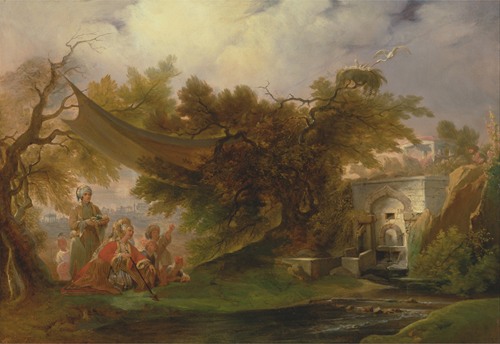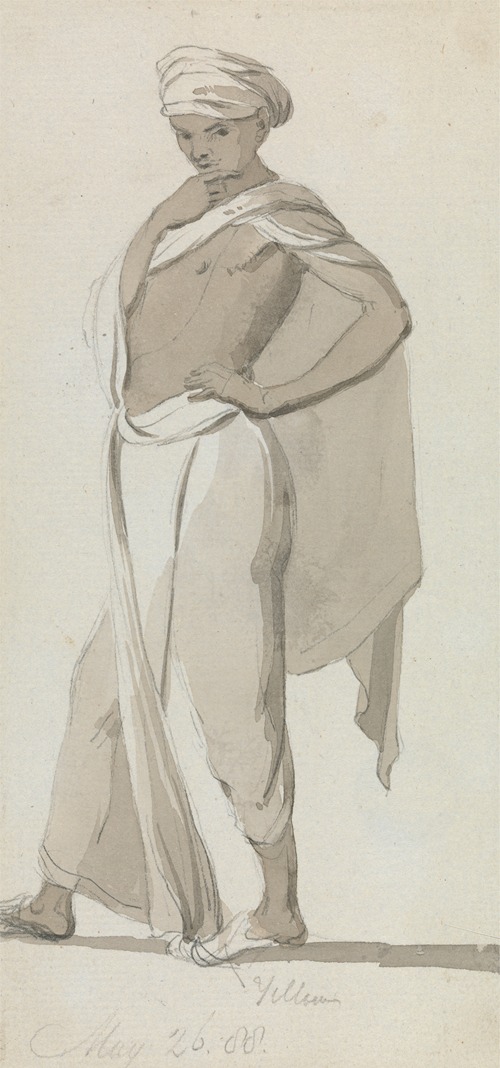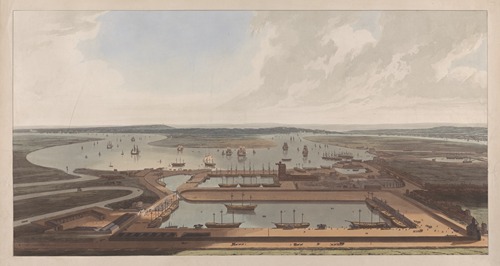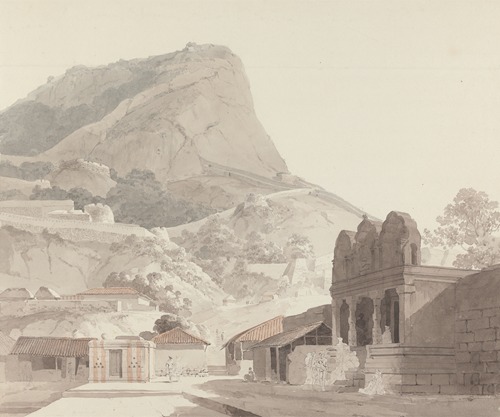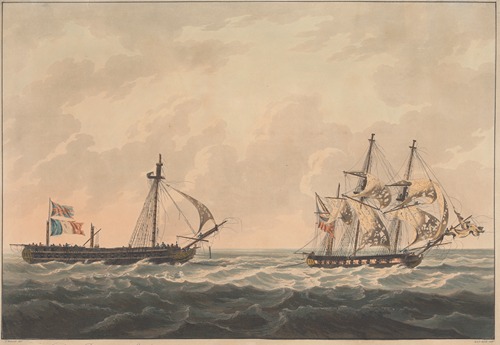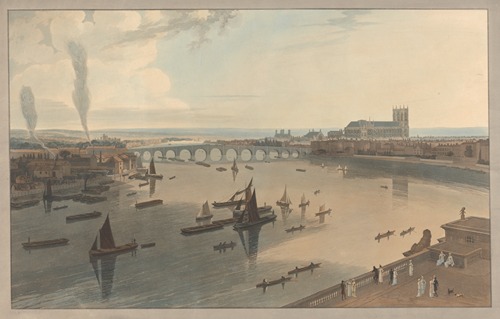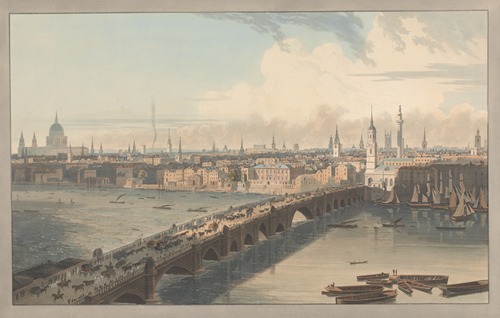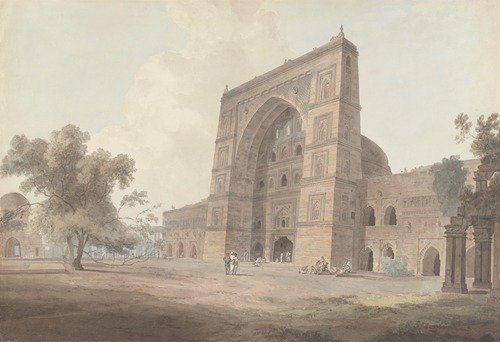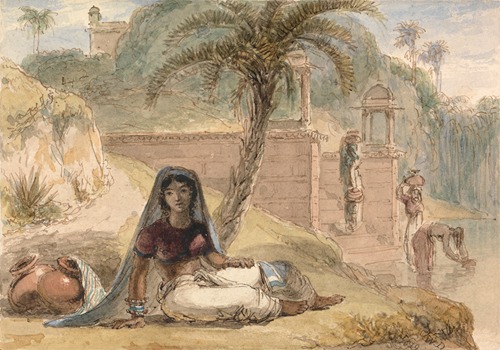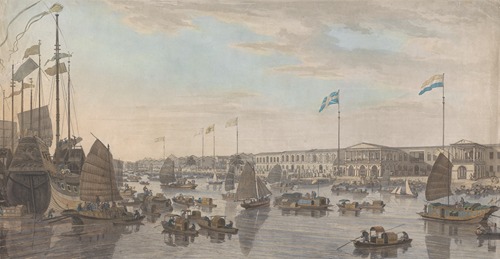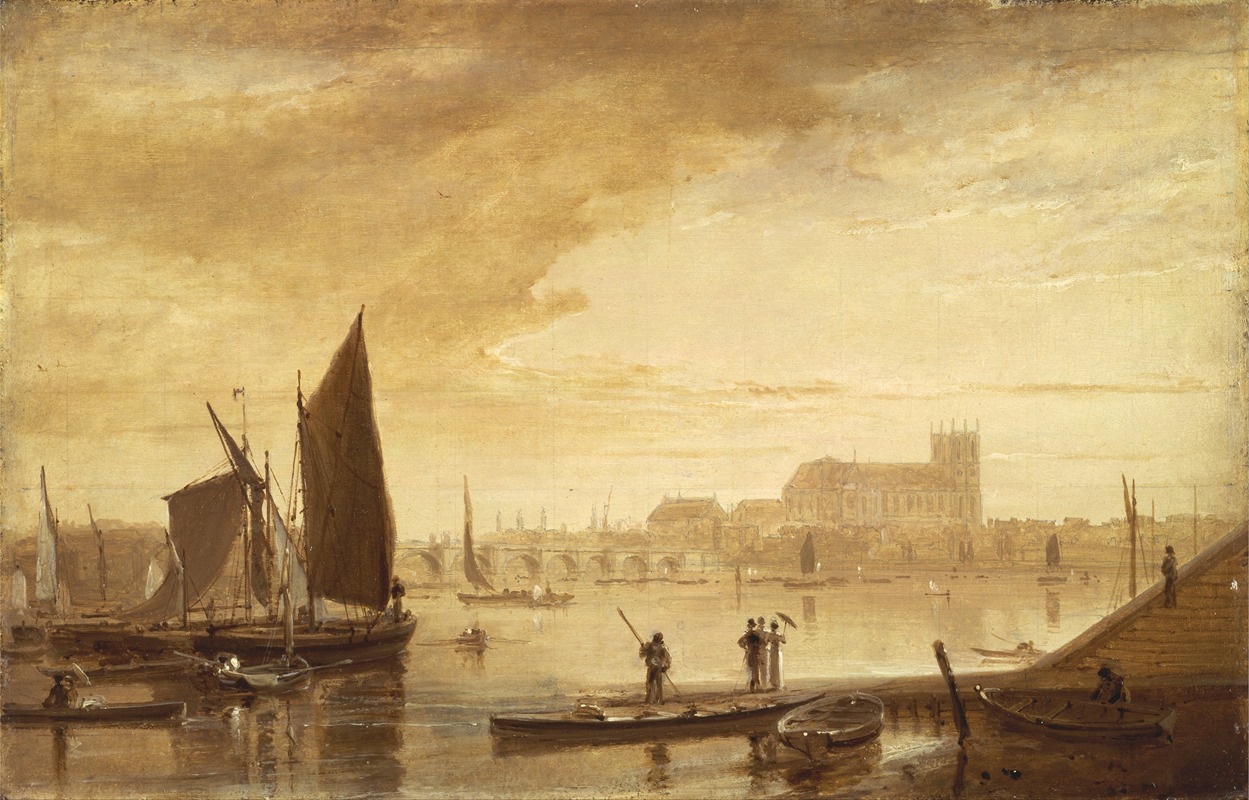

William Daniell RA was an English landscape and marine painter, and printmaker, notable for his work in aquatint. He travelled extensively in India in the company of his uncle Thomas Daniell, with whom he collaborated on one of the finest illustrated works of the period – Oriental Scenery. He later travelled around the coastline of Britain to paint watercolours for the equally ambitious book A Voyage Round Great Britain. His work was exhibited at the Royal Academy and the British Institution and he became a Royal Academician in 1822.
William Daniell was born in Kingston upon Thames, Surrey. His father was a bricklayer and owner of a public house called The Swan in nearby Chertsey. Daniell's future was dramatically changed when he was sent to live with his uncle, the landscape artist Thomas Daniell (1749–1840) after his father's premature death in 1779. In 1784 William accompanied his uncle to India, who worked there on a series of prints, acting as his assistant in preparing drawings and sketches. William's brother Samuel Daniell remained independent of his uncle and also became a topographical artist; he went to South Africa in 1801 and after his return to England published African Scenery and Animals (1804–5), a collection of aquatints. From 1806 he lived in Ceylon.
Daniell was sixteen when he accompanied his uncle to India. On 17 July 1786, a few months after their arrival in Calcutta, Thomas Daniell placed an advertisement in the Calcutta Chronicle, announcing the forthcoming publication of a set of twelve views of the city. This seemed a promising idea, since Calcutta was rapidly expanding and its European inhabitants might be willing to buy prints showing its latest buildings. Both he and William were inexperienced printmakers and had to enlist the help of Indian craftsmen, but the set, executed in aquatint, was completed in November 1788 and sold well. Thomas then began planning an ambitious tour of northern India, possibly inspired by the wealth of picturesque scenery indicated in William Hodges's collection of aquatints, Select Views in India (1785–8). In August 1789, Thomas and William set off up-river past Murshidabad to Bhagalpur, where they stayed with Samuel Davis (1760–1819), an employee of the East India Company and a skilled amateur artist. They continued on to Kanpur and then travelled overland to Delhi, visiting Agra, Fatehpur Sikri and Mathura on the way; the following April they made a pioneering tour to Srinagar, Uttarakhand and Garhwal in the Himalayas.
Thomas and William Daniell were back in Calcutta at the end of 1791. They held a lottery of their completed work, using the proceeds to fund a tour to the South. Since the Third Mysore War was in progress, the Daniells suspected that a market existed among the British for oil paintings and drawings of the areas in which the conflict was taking place. They duly visited various hill-forts on their way south, as well as the huge and richly carved temples at Madurai, Mamallapuram and Rameswaram. Once back in Madras they held another lottery of their work and set off on a tour to western India. On their arrival in Bombay in March 1793 they met James Wales (1747–95), then busy drawing the area's cave temples. He took them to Elephanta, Karli and Kanheri among other places.
In September 1794 the Daniells returned to England. Over the period 1784 to 1794 William had kept a detailed diary of their travels. This is now in the British Library. After 1794 he no longer kept a diary and so we have no information in his own hand about the rest of his life. The Royal Academician, Joseph Farington, himself a landscape painter and topographical draughtsman, kept a diary from 1793 until he died in 1821. The Daniells were close friends of Farington. John Garvey has gone through the diary and extracted glimpses of William's private life and of his artistic work. The diaries are almost the only written record we have of the life of William Daniell.
In 1794, William and his uncle set up house at 37 Howland Street, Fitzroy Square. Their first priority was to publish a selection of their paintings of India. The views that were selected were made into aquatint prints, calling upon William's skills in this delicate medium. These skills were hard earned. Farington records in his diary that William had informed him that on his return to England he spent the next seven years working from six in the morning until midnight perfecting his aquatinting techniques.
The Daniells' great work on India, Oriental Scenery, was published in six parts over the period 1795–1808.
Daniell's years after 1804 included making 72 etchings after George Dance's highly finished pencil profile portraits of Regency London's artistic establishment. A Collection of Portraits were published over ten years from 1804. Many are now held by the National Portrait Gallery. For Rees's Cyclopædia he contributed drawings, but these have not been identified.
In 1813 Daniell decided to undertake what was to be his greatest artistic work, A Voyage Round Great Britain. His plan was to journey around the whole coast and record views of places of interest. An integral part of the venture was to provide a running commentary, which described the scenery and the conditions of the people. Daniell had already had excursions in England, Wales and Scotland and so he had a good idea where to go and what he might find by way of subjects for paintings.
A Voyage Round Great Britain was published by Longman in eight volumes over the period 1814 to 1825. The complete set of eight volumes was priced at £60. The final number of prints included was 308. Garvey's book follows Daniell around part of the voyage, the Hebridean islands of Eigg, Rum, Skye and Raasay, locating the viewpoints included in his aquatint prints.
Over the period 1813 to 1825, in parallel with preparing the prints for the Voyage, Daniell was busy on other projects, which included paintings for the Academy Exhibitions. Many of the works exhibited were oil paintings of Scottish scenes. The artistic quality of the paintings and aquatints produced and published by Daniell for A Voyage Round Great Britain was considered to be very high. The atmospheric effects which he was able to convey in the aquatint medium were quite overwhelming. This was particularly true of his portrayal of ships and maritime scenery, as he had demonstrated in many earlier paintings and prints. In February 1822 after many years of endeavour, Daniell was finally elected an R.A. In the final ballot the voting was between John Constable and Daniell, the result being 11 to 17.
William produced a number of marine paintings. One, The Burning of the "Kent" is in the Museum of the Queen's Royal Surrey's, having been rediscovered after having disappeared for over a hundred years. It is an illustration of the dramatic loss of the East Indiaman Kent, and the rescue of some 550 survivors of her 650 crew and passengers.
His shipping scenes, such A Bird's-Eye View of the East India Dock at Blackwell (National Maritime Museum, London), were supplemented by greatly admired battle pieces. In 1825, he won a prize of £100 for a pair of paintings depicting the Battle of Trafalgar, exhibited at the British Institution. Daniell turned to panorama painting before his death, beginning in 1832 with a painting of Madras, including a depiction of the Hindu mode of taming wild elephants.
Daniell's last great artistic work was produced between 1827 and 1830. Over this time he became interested in the scenery around Windsor. In 1827, 1828 and 1830, he exhibited a total of five oil paintings of Windsor Castle and its surroundings and two oil paintings of Virginia Water, at the Royal Academy Exhibitions. These were considered to be among his finest oil paintings, and according to Sutton, his view of the Long Walk at Windsor was generally acknowledged to be his masterpiece in oils. Daniell produced a set of 12 aquatints of the Windsor and Virginia water views. Sutton writes of this series:
These twelve prints are the finest aquatints ever made, standing alone at the highest possible peak: aquatint could go no further, and although attempts have been made by others to excel them, none succeeded. The prints were made in Daniell's usual way, engraved by himself from his own drawings, and published by himself at 14, Russell Place, Fitzroy Square. By this time he was a comparatively wealthy man, and one can imagine him lovingly and carefully tinting the plates, leisurely savouring their subtle beauties, unhampered by time or financial worry. We feel, in looking at these aquatints, that perhaps Daniell, with the philosophy of a much-travelled man, realised that in the cool greys and greens with which he "stained" his prints was the charm of his own land, more enduring than the exotic mystery of the Orient or the strange architecture of Hindistan.
Daniell worked right up to his death, on 16 August 1837 at Brecknock Terrace, Camden Town (now 135 St Pancras Way). The house is marked by a commemorative plaque. He submitted five pictures to the Royal Academy Summer Exhibition in that year.

